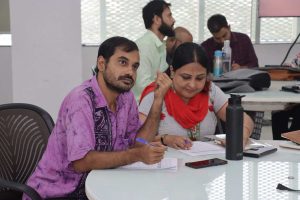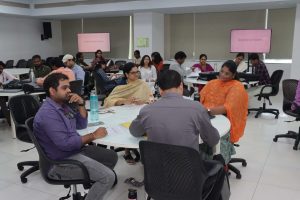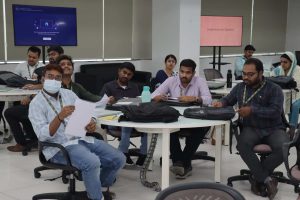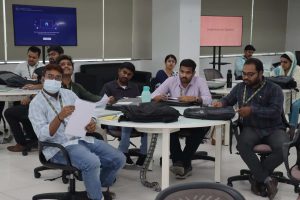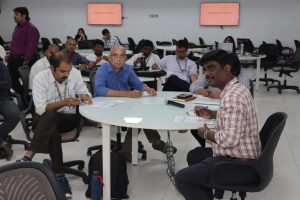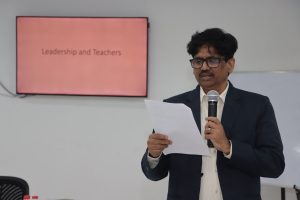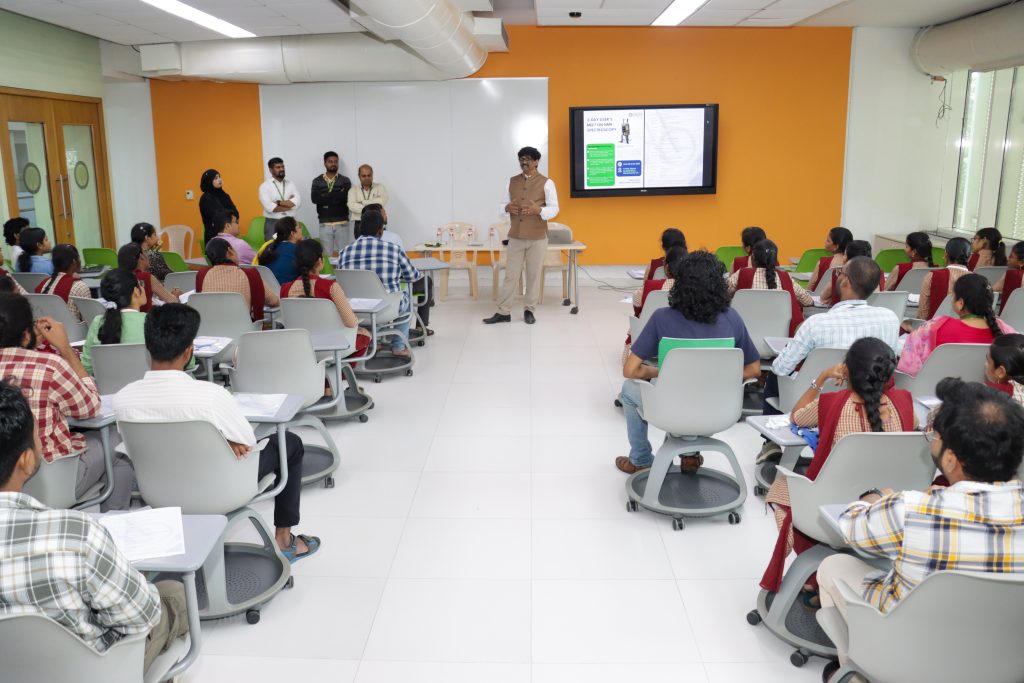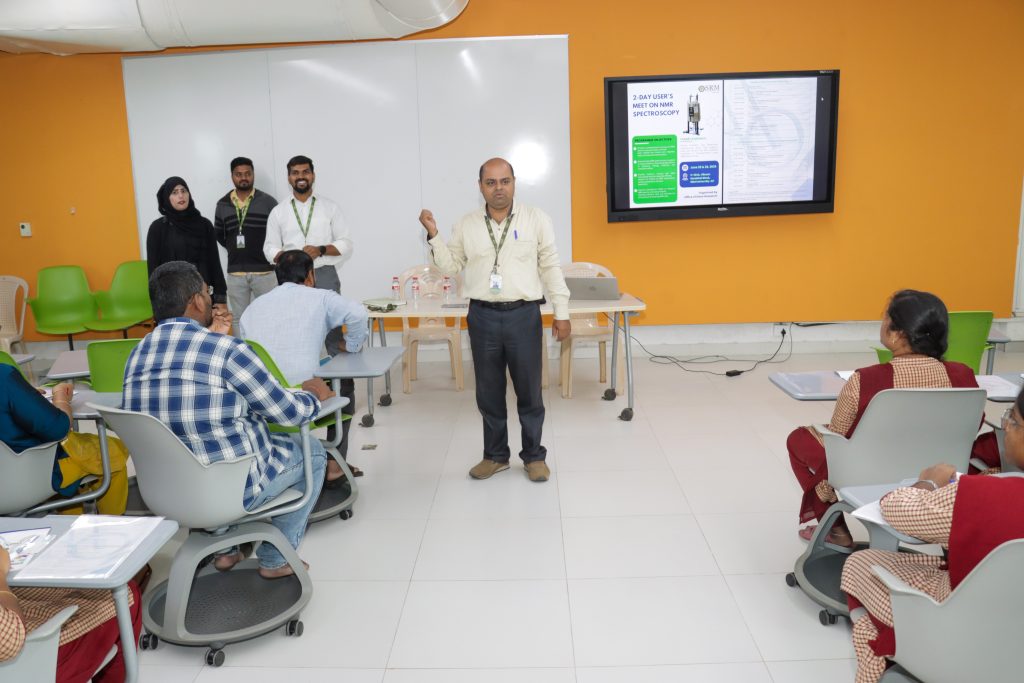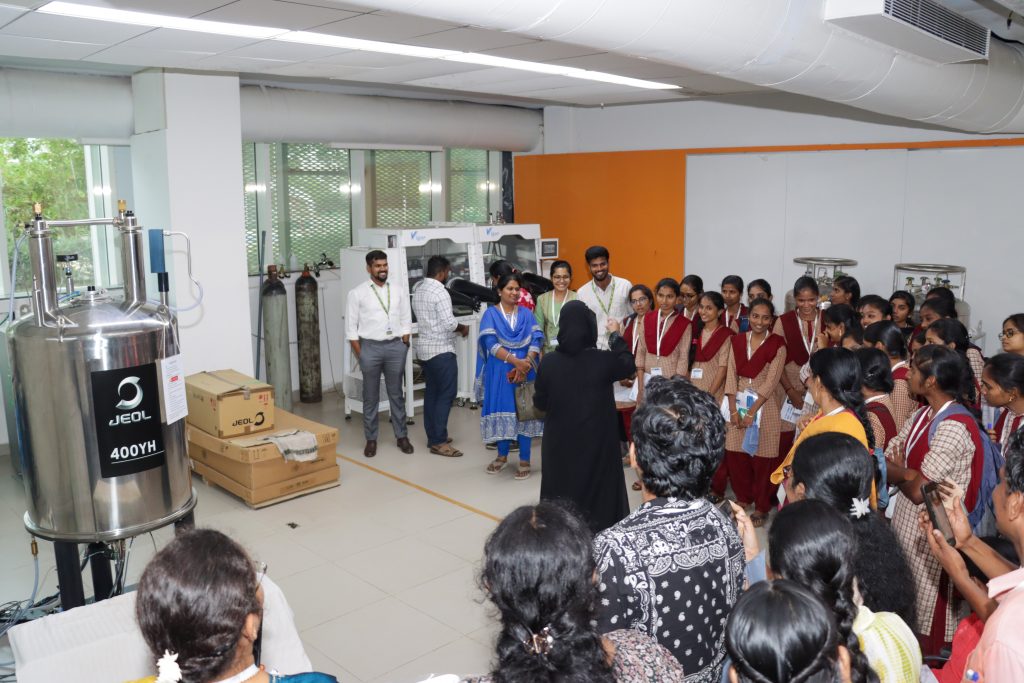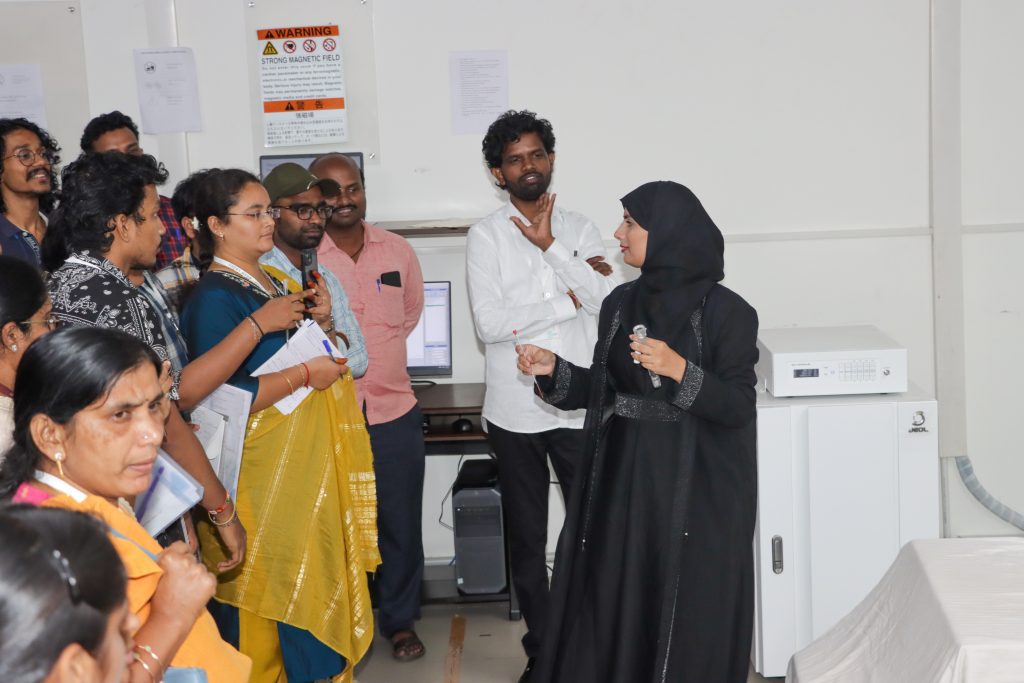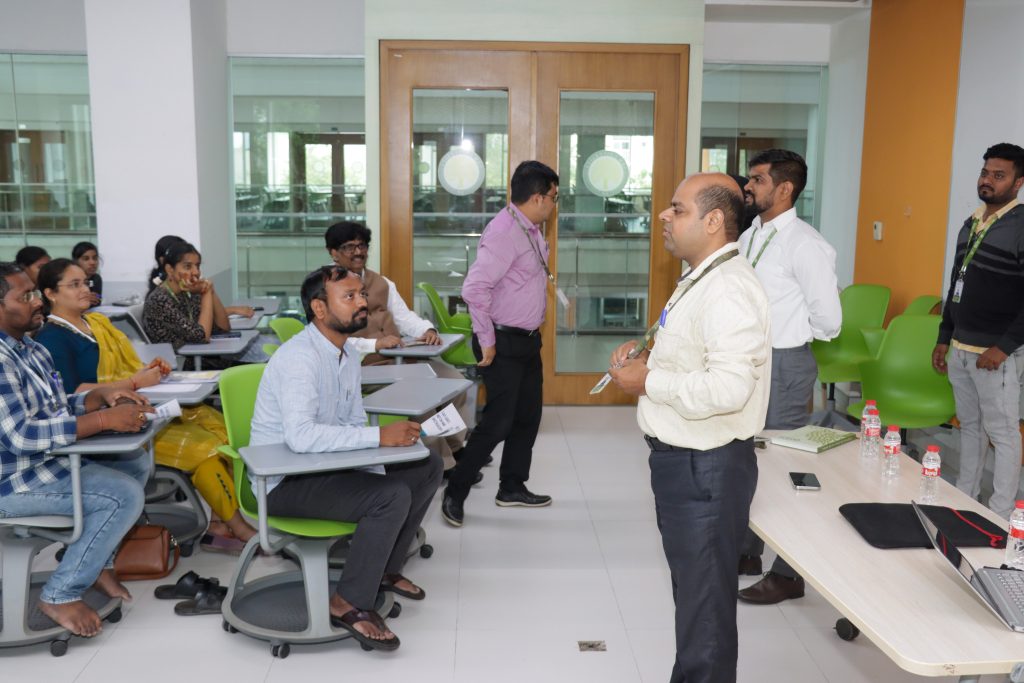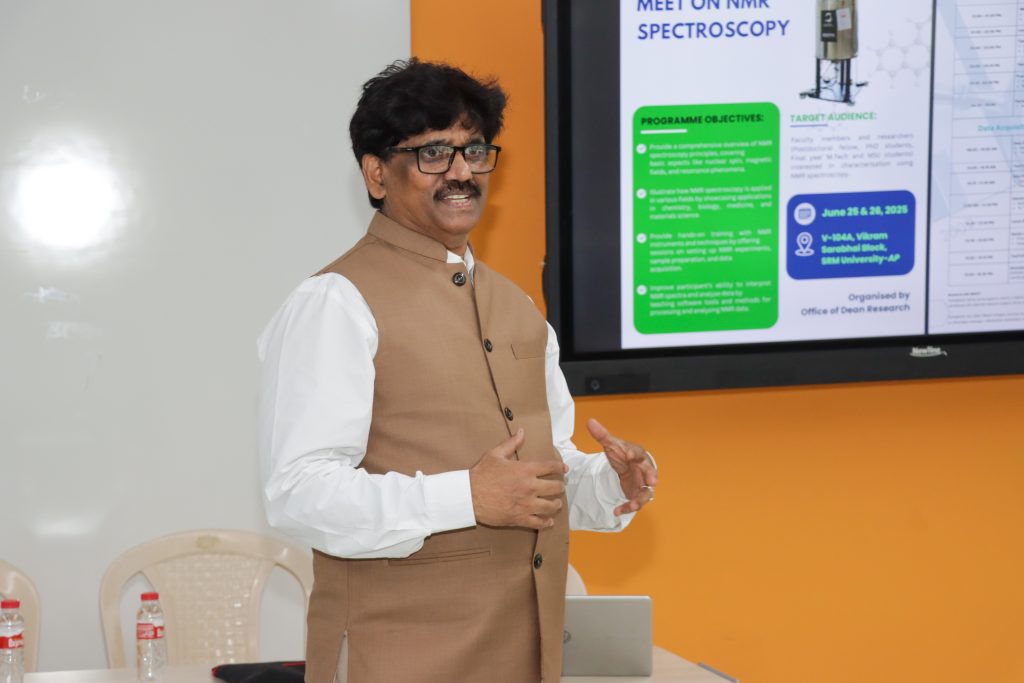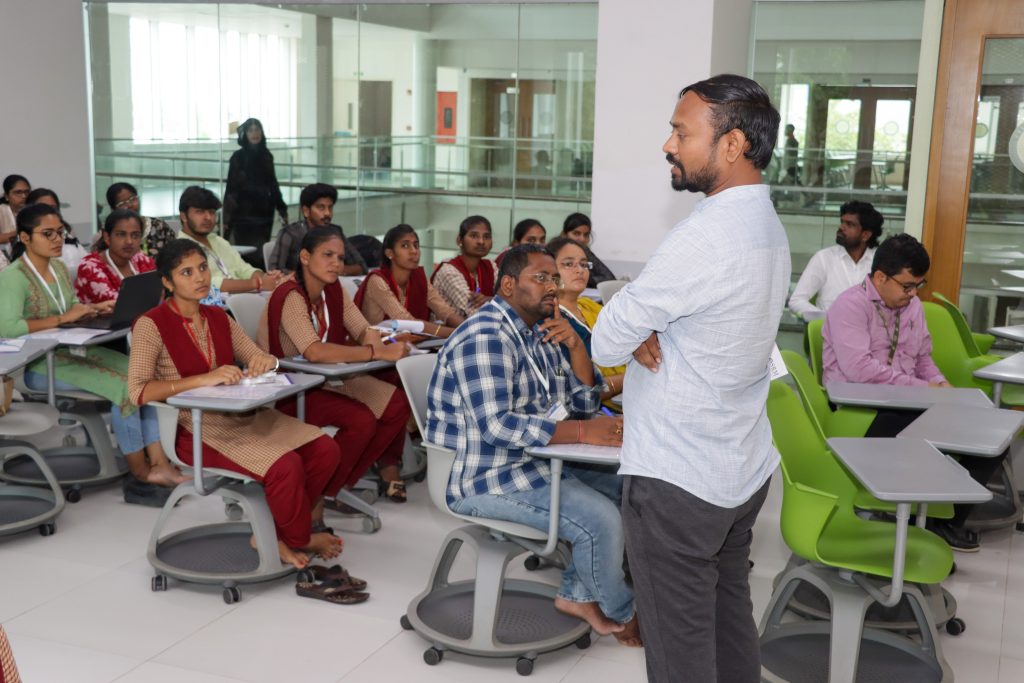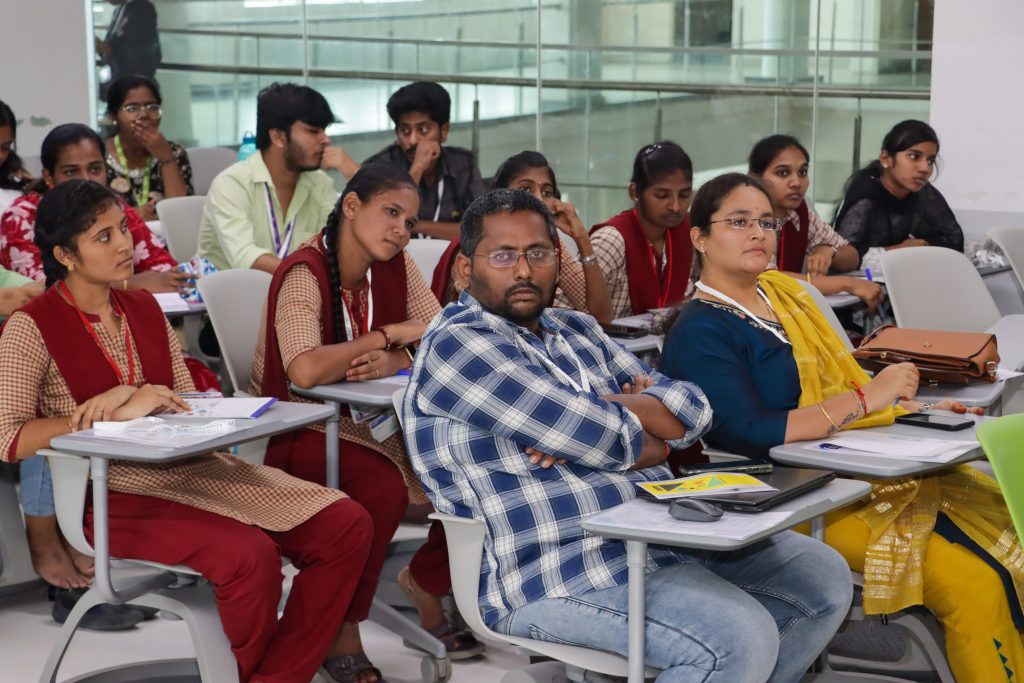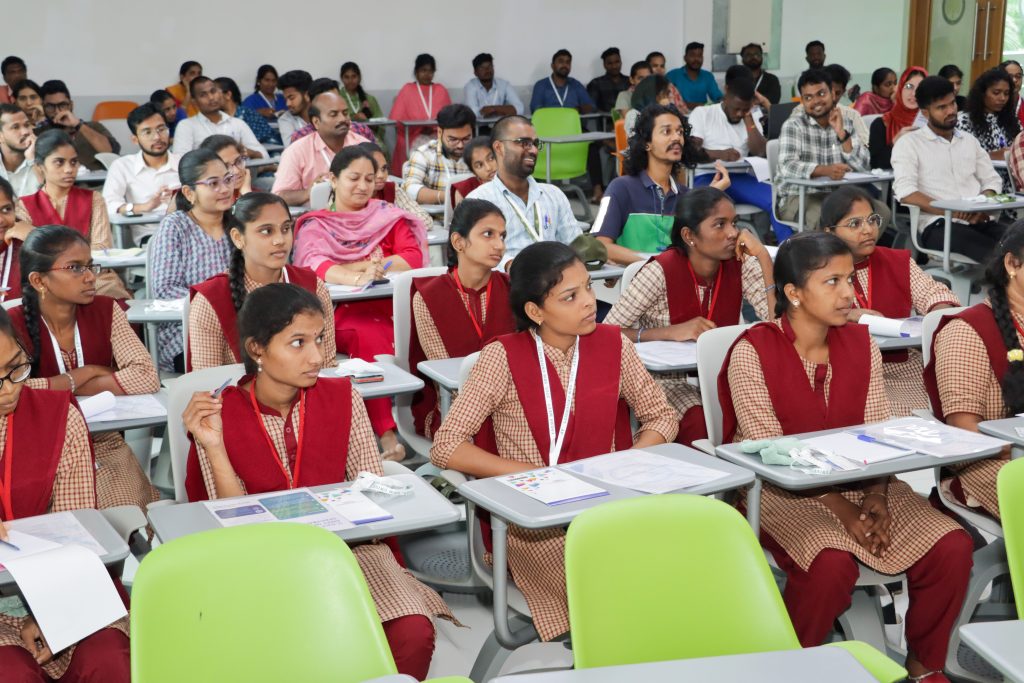A Smart System for Optimised AAV Localization
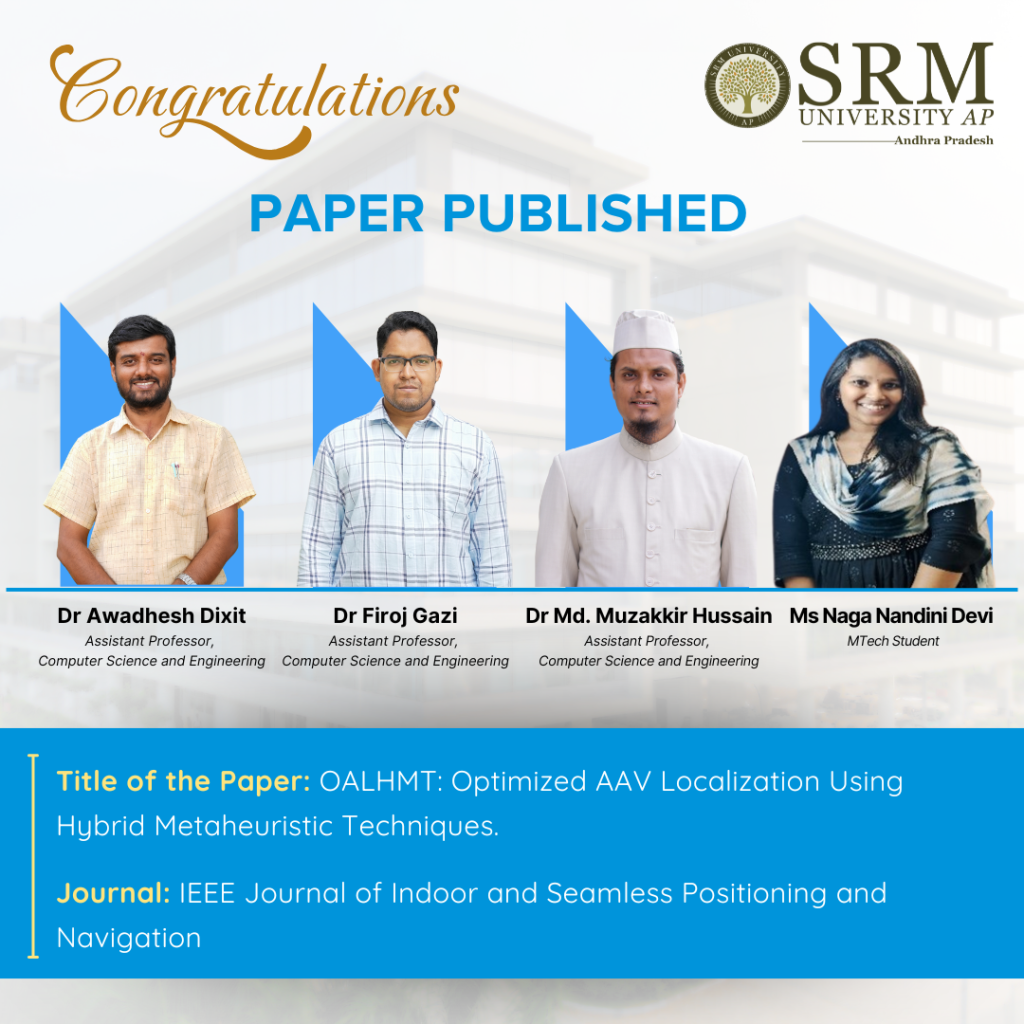
By combining Particle Swarm Optimisation (PSO) and Fuzzy Logic, the team at SRM AP has discovered a hybrid smart system for accurate localization of autonomous aerial vehicles (AAVs). Dr Awadesh Dixit, Dr Firoj Gazi, Dr Muzakkir Hussain Md, Assistant Professors and MTech student Ms Naga Nandini Devi from the Department of Computer Science and Engineering, have published their research article “OALHMT: Optimised AAV Localization Using Hybrid Metaheuristic Techniques” in the IEEE Journal of Indoor and Seamless Positioning and Navigation, that discloses the making and implementation of this smart system that is precise and works better than current methods for positioning and navigation.
Abstract
Accurate localization remains a critical challenge for autonomous aerial vehicles (AAVs) due to their high-speed, multidirectional movement. Precise positioning is essential for efficient resource management and task reallocation during flight. This research proposes a bioinspired hybrid model combining Particle Swarm Optimization (PSO) with fuzzy logic to enhance AAV localization accuracy. PSO effectively explores the search space to identify optimal positions, while fuzzy logic fine-tunes the solution using real-time environmental inputs such as signal strength, sensor noise, and GPS inaccuracies. This synergistic approach leverages PSO’s global optimization with the contextual adaptability of fuzzy systems, delivering robust and precise localization under dynamic and noisy flight conditions. Comparative evaluations with existing methods demonstrate the model’s superior accuracy and responsiveness in real-time AAV operations.
Practical Implementation/Social Implication of the Research
Proposed hybrid optimization for Indoor localization through swarm UAVs, localization methods for autonomous aerial vehicles (AAVs) typically rely on the global positioning system (GPS), which is effective in open environments. GPS provides accurate real-time positional data, making it widely used for outdoor AAV localization.
The team will continue to focus on developing swarm-based V2X communication and coordination, and reduced interference, secure communication for enhance UAV networks performance, advance AI-related applications.
Link to the article
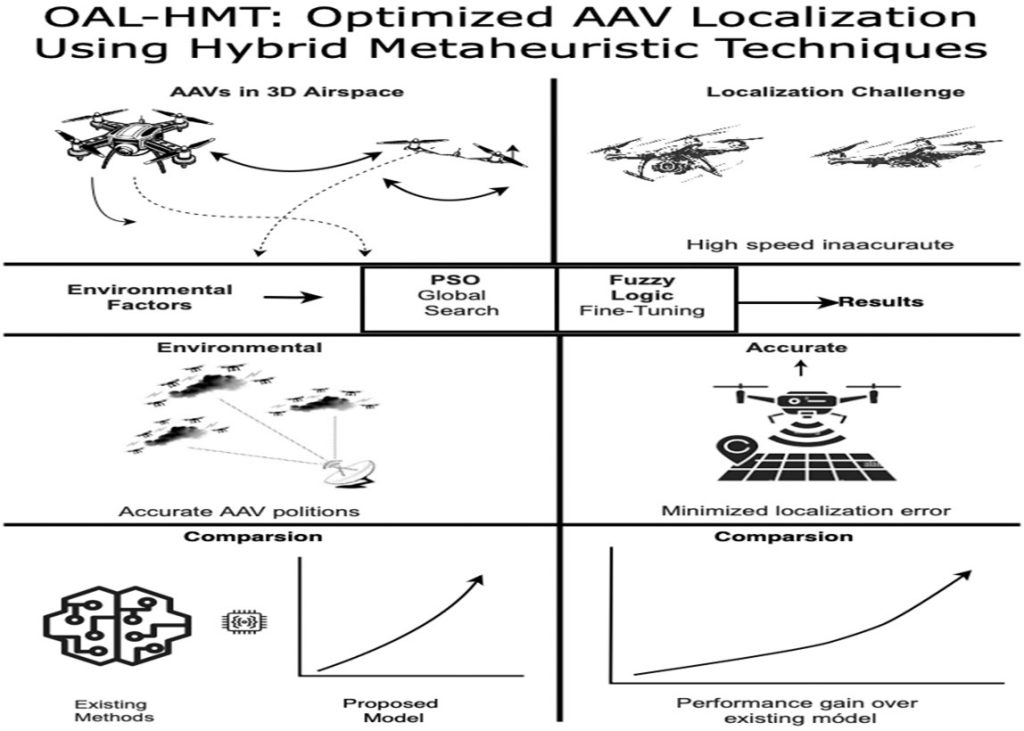
Overall abstract diagram of the paper
- Published in CSE NEWS, Departmental News, News, Research News
Transforming Teaching Through Upskilling
In an effort to upskill the faculty and to align them with the contemporary methodologies and classroom management techniques, the Teaching Learning Centre has launched a five-day faculty Development Programme.
The five-day upskilling session will see the presence of eminent educationists and trainers, including Vice Chancellor Prof. Manoj K Arora, Pro-Vice Chancellor Prof. Ch Satish Kumar; Prof. Edamana Prasad, Head-Teaching Learning Centre, IIT Madras; Dr S Mannathan, Associate Director-Teaching Learning Centre, SRM AP; Ms Rupa Murghai, Head-Wellness Centre, B M L Munjal; Dr Karthik Rajendran, Associate Director-QAR; Dr Srabani Basu, Associate Professor; and Dr Manikandan V M, Associate Professor.
The inaugural session featured Vice Chancellor Prof. Manoj K Arora, who delivered a compelling presentation on “Introduction and Goal Setting for Teaching & Learning.” Prof. Arora began the session on a reflective note, asking, “What is education, and why is it important?” In his remarks, Prof. Arora emphasised that students today are exceptionally smarter, and as a teacher it is important that we rise up to the challenge, not just by staying informed, but also by staying ahead of them.”
He also referenced an important question by a student, which he implored every educator to work upon and which encapsulates the concept of inclusive and adaptive teaching and learning:“If I can not learn the way you teach, will you teach me the way I can learn?”
Pro-Vice Chancellor, Prof. Ch Satish Kumar, during his session on “Leadership and Teachers” analysed leadership styles among teachers. He also quoted the Gurukul system, where the teacher used to be at the centre of power, the roles have now been reversed; However, the influence of a teacher continues to surpass generations. He remarked, “Leaders do not just lead, they have this power to influence people, a teacher is the same, their influence goes beyond the classroom.”
The five-day event touched upon relevant topics such as Multiple Intelligence,Learning Outcomes,Technology in Teaching,Active Learning Strategies,Student Mental Health, the Use of AI in Education, and Storytelling in Teachin to name a few.
The SRM AP aims to facilitate such constant upskilling in order to promote innovation, adaptability, and long-term career growth for individuals in an ever-evolving job market.
- Published in Departmental News, News, TLC
Invited Talk on Understanding Microphysics of Raindrops for Accurate Rainfall Forecasting
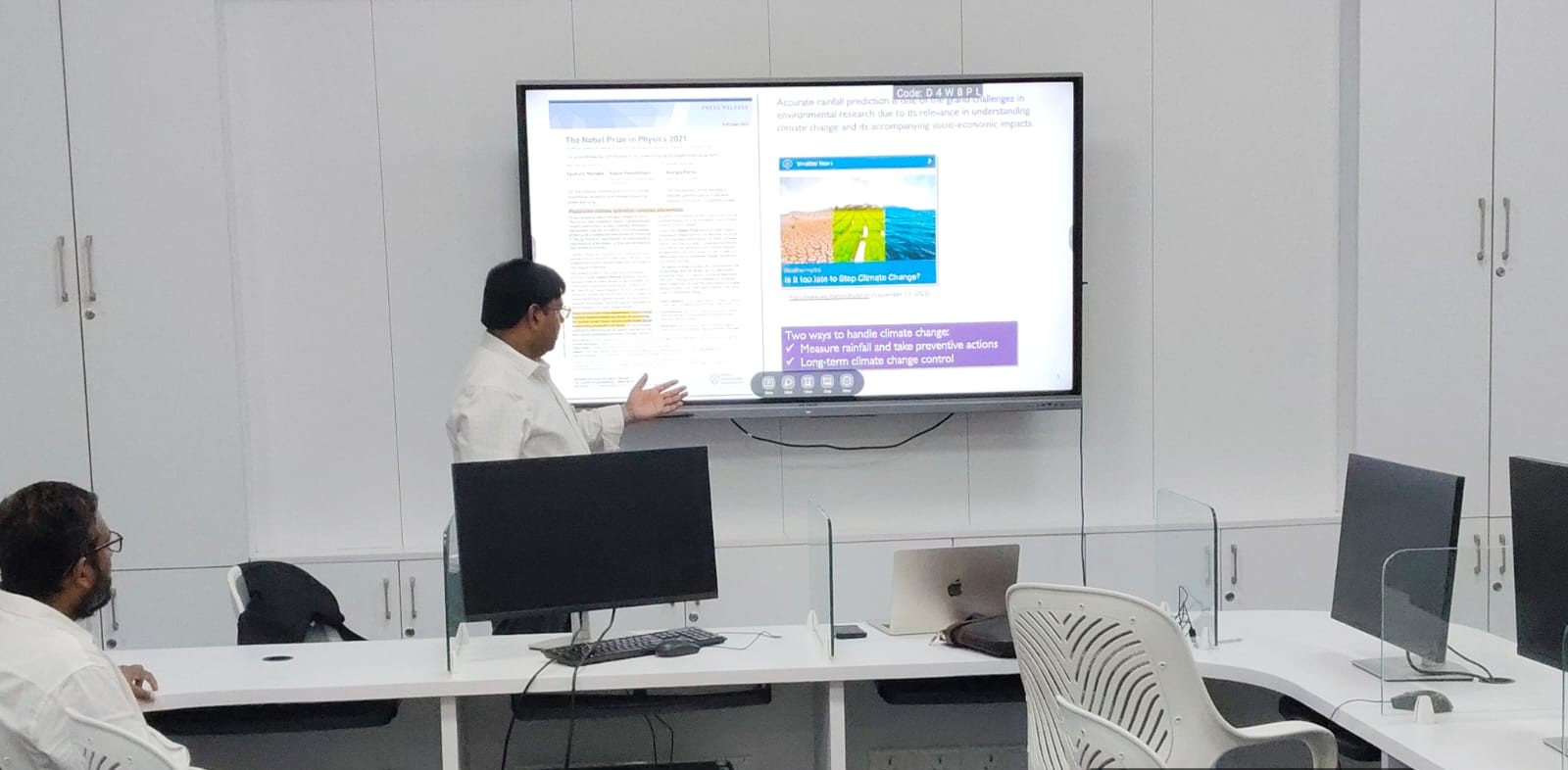 The Department of Mechanical Engineering hosted a Guest talk on “Understanding Microphysics of Raindrops for Accurate Rainfall Forecasting”. The session was presented by Prof. Kirti Chandra Sahu, distinguished Professor of the Department of Chemical Engineering at Indian Institute of Technology (IIT) Hyderabad, India. His research focuses on clouds and raindrops dynamics, interfacial fluid flows, and hydrodynamic instabilities.
The Department of Mechanical Engineering hosted a Guest talk on “Understanding Microphysics of Raindrops for Accurate Rainfall Forecasting”. The session was presented by Prof. Kirti Chandra Sahu, distinguished Professor of the Department of Chemical Engineering at Indian Institute of Technology (IIT) Hyderabad, India. His research focuses on clouds and raindrops dynamics, interfacial fluid flows, and hydrodynamic instabilities.
During the session Prof. Kirti Chandra Sahu emphasised the significance of understanding the microphysics of raindrops for accurate rainfall forecasting, highlighting the role of droplet formation, coalescence, and raindrop breakup under atmospheric conditions. He highlighted how progress in fluid dynamics, when integrated with computational modelling, can significantly strengthen weather prediction capabilities and contribute to climate-resilient strategies through interdisciplinary research. The event highlighted the role of fluid instabilities, surface tension effects, and computational modelling in understanding atmospheric microphysics. The session was highly interactive and informative, bridging the gap between theoretical fluid mechanics and real-world applications in weather forecasting.
The event was successfully led by a team of faculty members Dr Surfarazhussain S Halkarni, Dr Chandan Kumar, and Dr Manjesh Kumar, who played key roles in coordination, technical facilitation, and audience engagement. The talk concluded with an engaging Q&A session, where participants explored potential interdisciplinary collaborations and applications.
Prof. Kirti Chandra Sahu encouraged faculty members, research scholars, and students to explore this emerging domain, citing its growing relevance in tackling climate-related challenges. The event was a resounding success, fostering academic curiosity and encouraging further research.
About the Speaker :
Prof. Kirti Chandra Sahu received several prestigious recognitions, including the Young Scientist Awards from the Indian National Science Academy and the National Academy of Sciences, and the VASVIK Award.
He is a Fellow of the Indian Academy of Sciences and the Institute of Physics (UK). Prof. Sahu also serves as an Associate Editor for Industrial & Engineering Chemistry Research and is on the editorial board of Langmuir journal. He is currently a member of the External Affairs Committee of the American Physical Society’s Division of Fluid Dynamics (2024–2026).
- Published in Departmental News, Mechanical Engineering NEWS, News
Exploring New Frontiers in Computing: Expert Lecture by Dr Aditya Japa
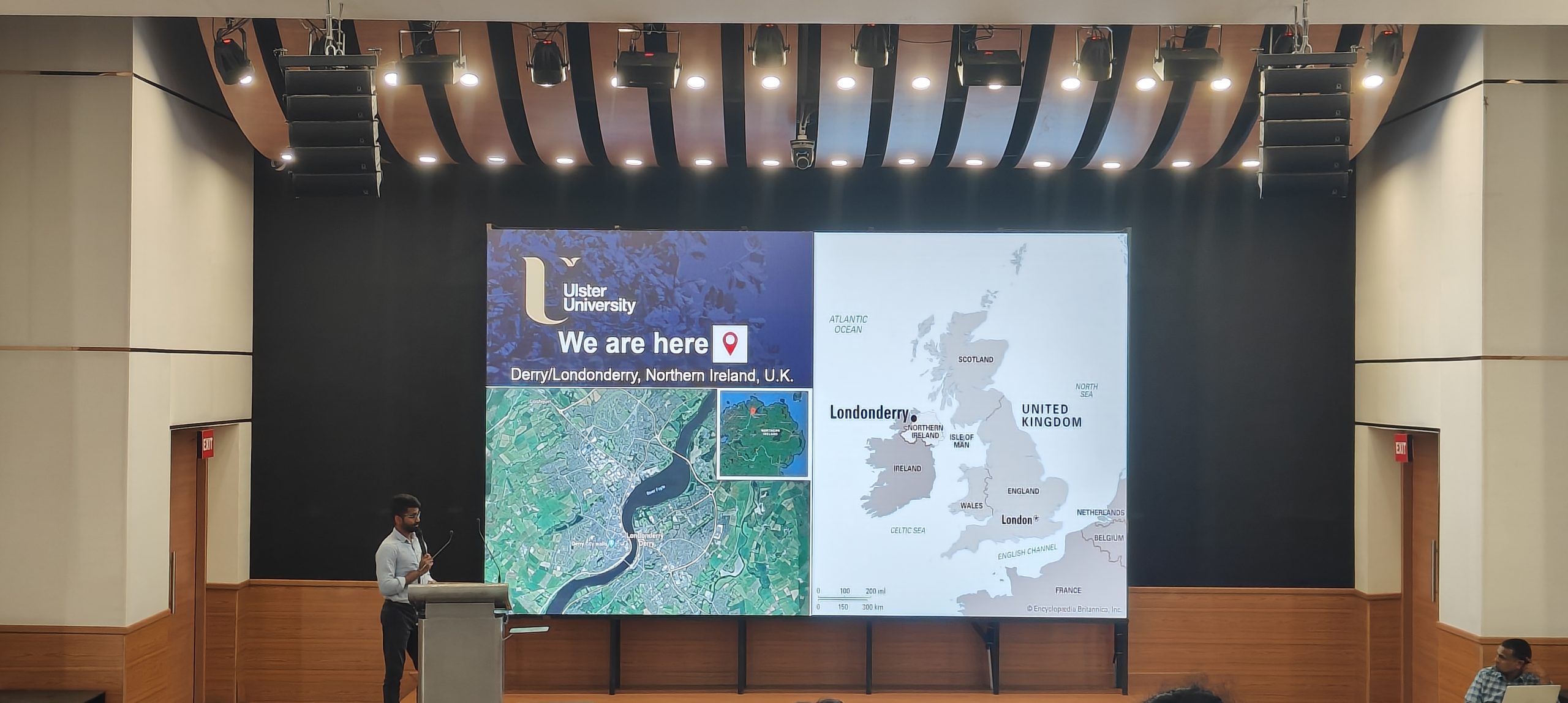 The Department of Electronics and Communication Engineering (ECE) at SRM University-AP, Amaravati recently hosted a thought-provoking guest lecture on “Approximate Computing and Hardware Security: Opportunities and Risks”, featuring Dr Aditya Japa, a renowned researcher and faculty member at the School of Computing, Engineering and Intelligent Systems, Ulster University, UK.
The Department of Electronics and Communication Engineering (ECE) at SRM University-AP, Amaravati recently hosted a thought-provoking guest lecture on “Approximate Computing and Hardware Security: Opportunities and Risks”, featuring Dr Aditya Japa, a renowned researcher and faculty member at the School of Computing, Engineering and Intelligent Systems, Ulster University, UK.
The session organised by Dr Ramesh Vaddi, Associate Professor, Department of ECE brought together over 110 participants, including faculty, PhD scholars, and UG/PG students, eager to gain insights into the evolving paradigms of energy-efficient and secure hardware design.
Dr Japa holds a Ph.D. in Electronics and Communication Engineering from Dr SPM IIIT Naya Raipur, India, with specialisation in emerging technologies for hardware security. His illustrious academic journey includes significant research contributions at Queen’s University, Belfast, and a published book titled “Introduction to Microelectronics to Nanoelectronics: Design and Technology.” His current work at Ulster University revolves around hardware and system security, particularly in Physical Unclonable Functions (PUFs), True Random Number Generators (TRNGs), and security strategies for approximate computing.
Key Highlights of the Lecture
Approximate computing is fast emerging as a compelling approach for building high-performance and energy-efficient systems, especially for error-tolerant applications like multimedia processing, AI, and big data analytics. However, this paradigm also introduces unique security challenges and opportunities, as explored in-depth by Dr Japa.
Key points covered included:
- Threat Models in approximate circuits and memory architectures such as DRAM and SRAM, revealing vulnerabilities to side-channel attacks, reverse engineering, and hardware Trojans.
- How approximate hardware, despite risks, can serve as a platform for resource-efficient security primitives.
- Security through approximation: Leveraging simplified circuits for information hiding and obfuscation, maintaining security with significantly reduced computational cost.
- Future research directions including secure-by-design architectures, cross-domain applications, and standardised benchmarking tools.
The session aimed to expose students and researchers to state-of-the-art advancements in hardware security and to encourage critical thinking around the duality of risk and opportunity in approximate computing. Participants walked away with a deeper understanding of:
- Designing systems that are both efficient and resilient.
- Emerging countermeasures against approximation-induced vulnerabilities.
- The strategic role of interdisciplinary research in addressing these challenges.
Recommendations for Further Action
- The event also sparked actionable recommendations for academia and industry:
- Develop approximation-aware threat models for various application domains.
- Design architectures that are secure by approximation.
- Invest in benchmarking and validation tools for secure approximate systems.
- Encourage cross-domain research in computing, security, and AI.
- Promote education and policy development in secure hardware design.
Events like these reflect SRM University-AP’s unwavering commitment to academic excellence, industry-relevant training, and research-led learning. The ECE department continues to serve as a platform for knowledge exchange and global collaboration, preparing students for the next generation of technological innovation.
- Published in Departmental News, ECE NEWS, News
Transforming Sustainability with Innovative Catalysts
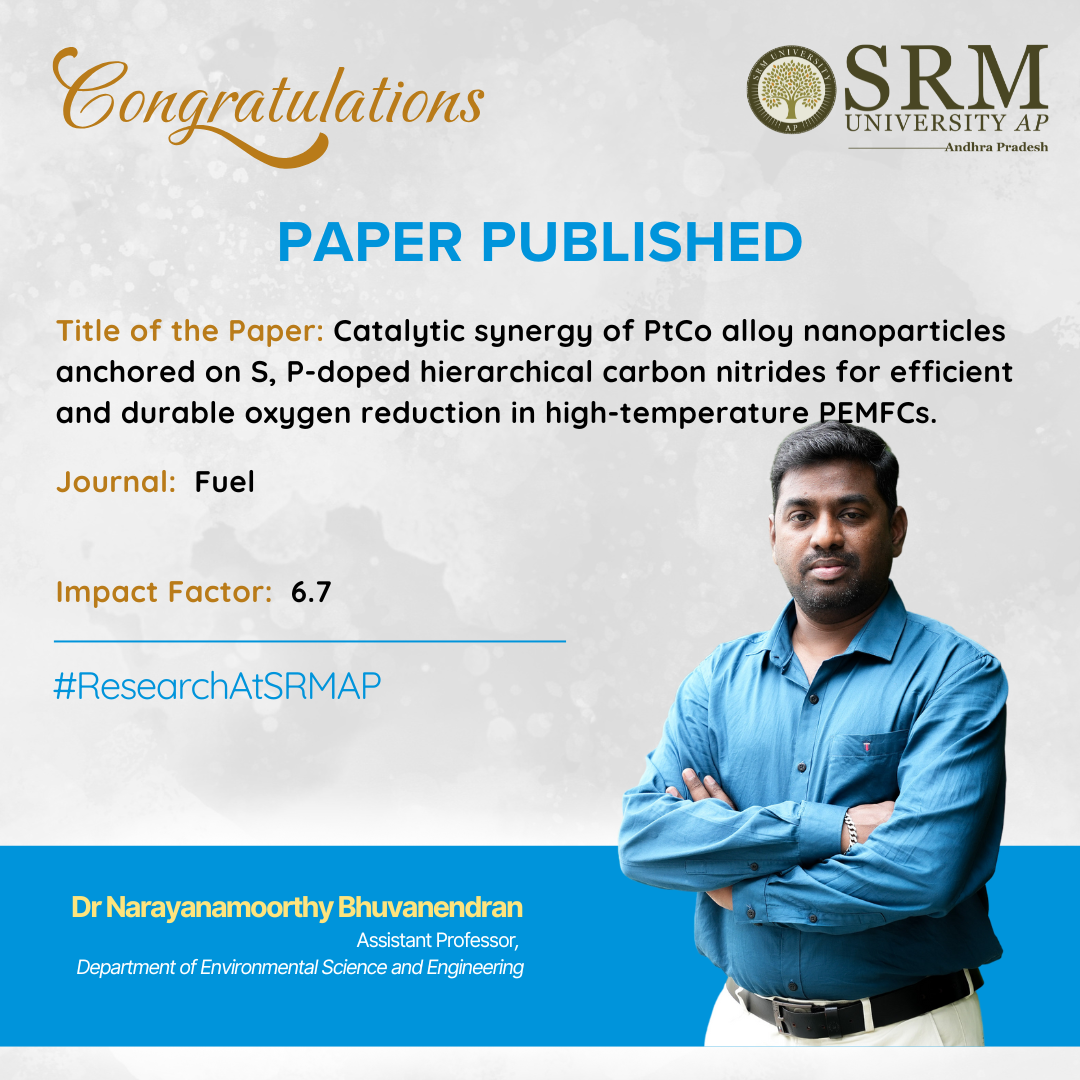 Assistant Professor, Dr Narayanamoorthy Bhuvanendran from the Department of Environmental Science and Engineering has published a research paper titled, Catalytic synergy of PtCo alloy nanoparticles anchored on S, P-doped hierarchical carbon nitrides for efficient and durable oxygen reduction in high-temperature PEMFCs. His research presents a new type of catalyst that could enhance the efficiency and longevity of fuel cells, making them more viable for sustainable energy applications.
Assistant Professor, Dr Narayanamoorthy Bhuvanendran from the Department of Environmental Science and Engineering has published a research paper titled, Catalytic synergy of PtCo alloy nanoparticles anchored on S, P-doped hierarchical carbon nitrides for efficient and durable oxygen reduction in high-temperature PEMFCs. His research presents a new type of catalyst that could enhance the efficiency and longevity of fuel cells, making them more viable for sustainable energy applications.
Abstract:
Intensified electrochemical corrosion under high-temperature and phosphoric acid conditions poses a significant challenge to the catalysts in high-temperature proton exchange membrane fuel cells (HT-PEMFCs). Herein, a S, P-doped hierarchical porous carbon nitride (S, P-HCN) supported PtCo alloy catalyst was developed to address this issue. The multilayered porous structure of S, P-HCN ensures high metal dispersion, a large specific surface area, and enhanced mass transfer. The PtCo/S, P-HCN catalyst exhibits remarkable performance, with specific activity (1.27 mA cmPt-2 at 0.80 V), mass activity (0.51 mA µgPt-1 at 0.80 V), and electrochemical active surface area (ECSA) (39.9 m2 g-1Pt), surpassing commercial 20 % Pt/C by 2–3 times. Durability tests over 5000 potential cycles reveal excellent retention of mass activity (84 %) and specific activity (83.2 %) at 0.80 V, with only a minor 14 mV shift in half-wave potential. This enhancement stems from the synergistic effects between PtCo alloy nanoparticles and S, P-HCN, which modulate Pt- electronic structure, strengthen metal-support interactions, and boost catalytic efficiency. Single-cell HT-PEMFC studies demonstrate a peak power density of 377.4 mW cm−2 for PtCo/S, P-HCN, comparable to commercial Pt/C (398 mW cm−2), with reduced voltage degradation at low current densities. This work presents a promising approach for improving cathode materials and advancing HT-PEMFC performance.
Explanation in Research in Layperson’s Terms:
The growing demand for green energy has increased the interest in clean, sustainable, and efficient fuel for electricity generation. Hence, hydrogen is one of the promising choices as green energy source, which can be used as a fuel in fuel cell technology. Among various types of fuel cells, proton exchange membrane fuel cells (PEMFCs) are the fastest-growing energy technologies, especially in automotive applications, owing to their high-power density and rapid start-up and shutdown capabilities compared to other fuel cell types. PEMFCs are classified by operating temperature into low-temperature (LT-PEMFC) and high-temperature (HT-PEMFC). While LT-PEMFCs (operating at ∼ 80 °C) have advanced significantly, they face challenges such as complex heat and water management and the high cost of producing the required high-purity hydrogen fuel. HT-PEMFCs, operating at 150–200 °C, overcome low-temperature PEMFC limitations with fuel flexibility, simpler design, improved water management, and greater efficiency, while enhancing oxygen reduction reaction (ORR) kinetics and diffusion processes. Till to date, Pt/C is the most used catalyst in PEMFCs due to its high activity and stability. However, in HT-PEMFCs, phosphate species from the phosphoric acid electrolyte strongly adsorb onto Pt surfaces, blocking active sites for O2 adsorption and reducing overall cathode performance. To address this bottleneck issues, a novel hybrid support materials with 3D hierarchical porous morphology, high surface area, porosity, and more accessible active sites has been developed which provides distinct benefits over conventional carbon materials for enhancing ORR performance. Their extensive surface area and interconnected pores facilitate better active site distribution and efficient mass transfer during the ORR process and leads to extended fuel cell performance.
Practical Implementation and Social Implications:
In this work, we have design and developed the PtCo/S,P-HCN catalyst, through a simple hydrothermal process, constructs a synergistic combination of structural and compositional features that significantly enhance the cathodic ORR performance. The 3D porous architecture with uniformly distributed PtCo nanoparticles and S, P-doped carbon nitride matrix ensures improved Pt utilization, active site accessibility, and effective charge transport. Nitrogen doping (graphitic-N and pyridinic-N) facilitates efficient electron transfer, while heteroatom doping (S and P) optimizes *OOH binding energy, promoting oxygen adsorption and O–O bond cleavage. The interatomic alloy structure of PtCo modulates the Pt d-band center, further boosting ORR kinetics. These combined effects result in superior catalytic activity (SA: 1.268 mA cmPt-2, MA: 0.506 mA µgPt-1, ECSA: 39.9 m2 g-1Pt) and durability, retaining 84 % MA and 83.2 % SA after 5000 cycles with minimal half-wave potential loss (14 mV). In HT-PEMFC tests, it achieved a peak power density of 377.4 mW cm−2, matching commercial Pt/C (398 mW cm−2), while demonstrating greater PA resistance and stability. These findings highlight the synergistic effects of the PtCo/S,P-HCN catalyst and its potential as a robust ORR electrocatalyst for HT-PEMFC applications.
Collaborations:
Prof. Huaneng Su, Jiangsu University, China.
Future Research Plans:
Based on the observations from the above research, we plan to further explore modifications to the electronic properties of the catalyst to enhance the surface adsorption of reaction intermediates, thereby improving its electrocatalytic performance for various key electrochemical reactions.
- Published in Departmental News, ENVS News, News, Research News
Team Ritorno Wins 1st Prize at ETHGlobal Cannes 2025, France
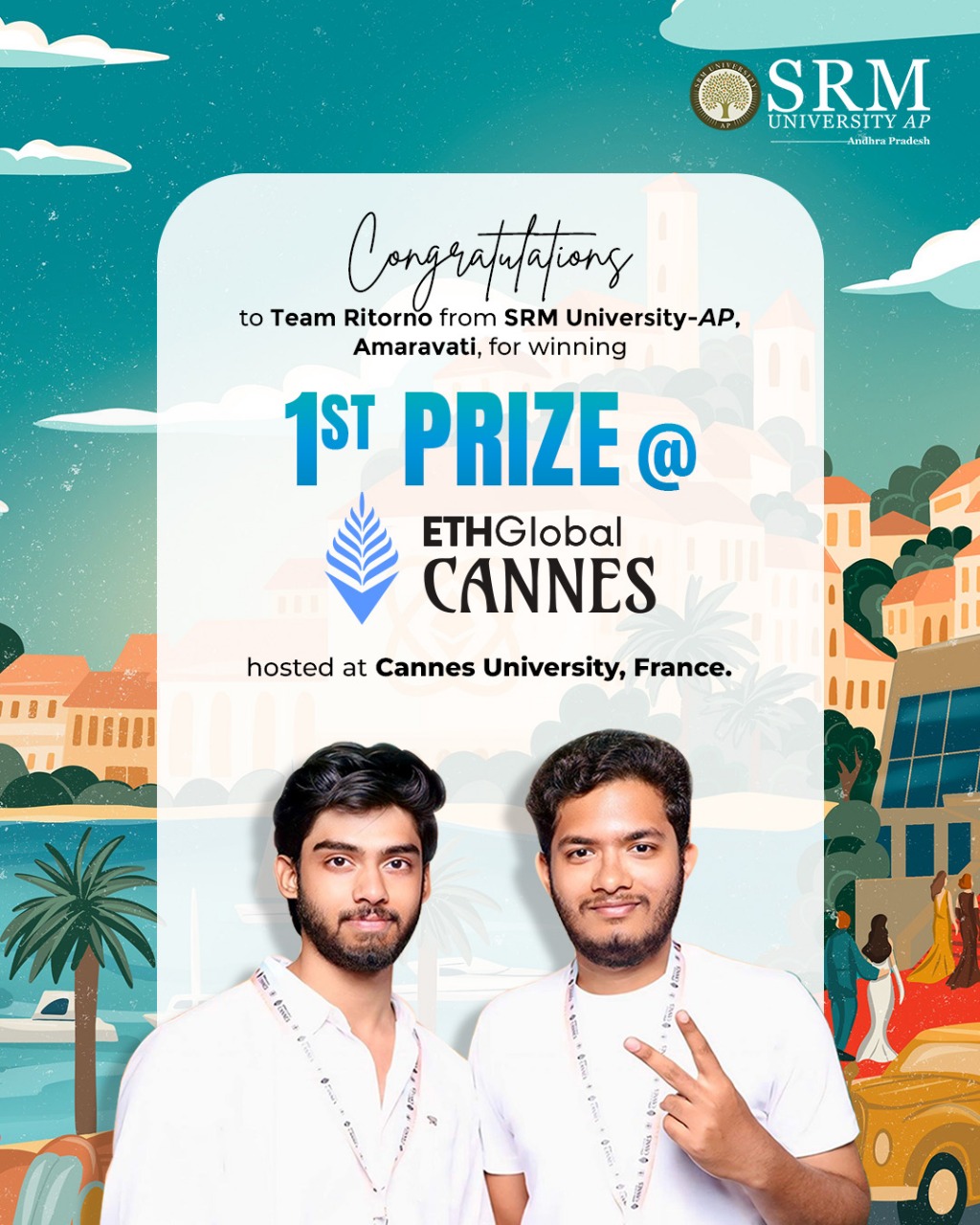 We are immensely proud to celebrate the outstanding achievement of Team Ritorno—Satwik Batta and Shashank Chowdhary —B. Tech Computer Science, 4th Year Student from SRM University-AP, Amaravati, who have brought global recognition to Indian talent by securing 1st Prize at ETHGlobal Cannes 2025, hosted at Cannes University, France, from July 4–6, 2025.
We are immensely proud to celebrate the outstanding achievement of Team Ritorno—Satwik Batta and Shashank Chowdhary —B. Tech Computer Science, 4th Year Student from SRM University-AP, Amaravati, who have brought global recognition to Indian talent by securing 1st Prize at ETHGlobal Cannes 2025, hosted at Cannes University, France, from July 4–6, 2025.
Competing against over 350 teams and 1,500 participants from around the world, Team Ritorno emerged as winners at one of the most prestigious Ethereum hackathons, earning a cash prize of $4,500. Their winning project, “Topological Self-Healing Smart Contracts,” impressed a global jury and showcased their deep technical expertise and innovative spirit.
About ETHGlobal Cannes
ETHGlobal is a leading global platform for Ethereum hackathons, bringing together thousands of developers across six continents. The Cannes edition featured a prize pool of $275,000, supported by blockchain industry leaders like Polygon, Coinbase, Gnosis Chain, 1inch Network, and others.
Selection & University Support
Team Ritorno was selected for ETHGlobal Cannes after submitting their resumes and a compelling project proposal. Their idea, Topological Self-Healing Smart Contracts, was highly appreciated by the ETHGlobal organisers.
Before the event, the team presented their project to the Research Office and the Dean of SRM-AP, who were enthusiastic about their innovation and generously extended financial support of ₹2,10,000 to enable their participation.
“We’ve been working in this field since our second year. Our consistent participation gave us the exposure and confidence to compete globally,” the team shared. “The last week leading to ETHCannes was intense, and we are grateful to our university and faculty for their unwavering support.”
Looking Ahead
With eyes set on careers in top-tier U.S.-based tech companies, the trio is eager to continue pushing boundaries in blockchain and decentralised technologies.
Congratulations, Team Ritorno!
You’ve not only made SRM University-AP proud but have also put India’s innovation ecosystem on the global blockchain map. Your journey is an inspiration for all aspiring technologists.
- Published in CSE NEWS, Departmental News, News, Students Achievements
Dr Pradhan and Team’s Breakthrough in Post-Stroke Rehabilitation
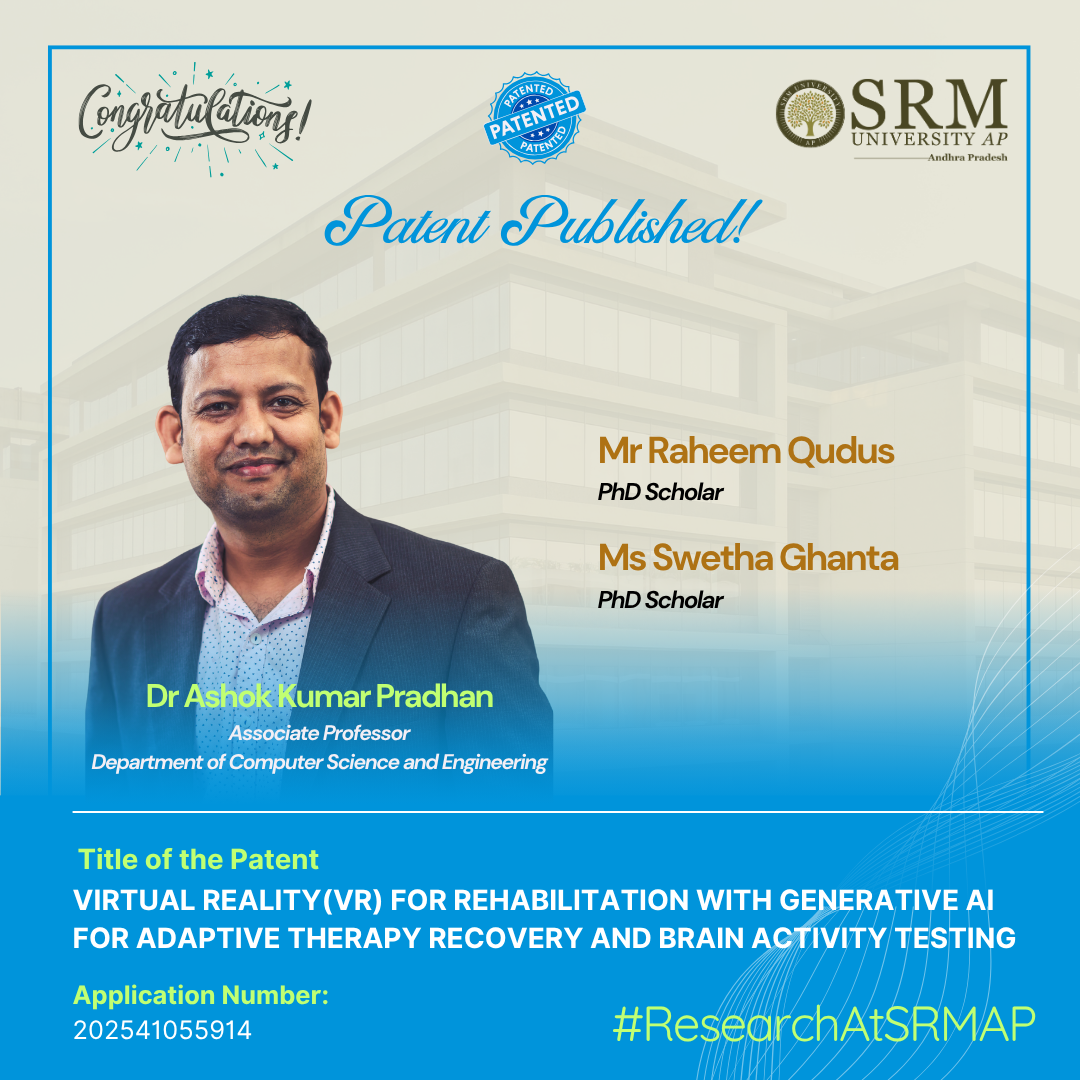 The Department of Computer Science and Engineering at SRM University-AP has yet again produced a scientific breakthrough. Associate Professor Dr Ashok Kumar Pradhan, along with his research scholars Mr Raheem Qudus and Ms Swetha Ghanta, published a patent on post-stroke rehabilitation using Virtual Reality and Artificial Intelligence.
The Department of Computer Science and Engineering at SRM University-AP has yet again produced a scientific breakthrough. Associate Professor Dr Ashok Kumar Pradhan, along with his research scholars Mr Raheem Qudus and Ms Swetha Ghanta, published a patent on post-stroke rehabilitation using Virtual Reality and Artificial Intelligence.
Brief Abstract of the Research
Stroke is one of the most significant health problems that aid disability and mortality in functionality of human health, While already there are varies approach, Traditionally and Technical methods developed to help patient overcome these challenges, common system to treat and help patients recovers from this are, using Local therapy approach, using EEG (electroencephalogram) and or using the BCI (Brain Computer Interface). However, not all patients find this approach applicable, suitable and affordable. The aim of this research is to perform Post-Stroke Rehabilitation recovery training and testing on patient without the need for Brain computer Interface (BCI) and Electroencephalogram (EEG), our proposed method provides similar embodiment and rehabilitation capabilities to those perceived from existing therapeutic techniques such as Constraint induced movement therapy (CIMT), Occupational therapy, mirror therapy and authenticating fear. Our Research approach resolution is to develop a virtual reality (VR) based system for post-stroke rehabilitation using Meta Quest (Headset) and Unity game engine for simulation of the virtual environment. Our emerging methods in integrating Generative-AI to provide adaptive therapy recommendations based on patient movements and engagement levels. While we implement the use of a real-time compensatory movement detection system without EEG, relying on AI-driven motion analysis.
Explanation in layperson’s terms:
After a stroke, patients often struggle to regain movement or perform simple tasks. Existing treatments rely on traditional and invasive signal equipment, such as wearing of electroencephalogram(EEG), and also require a professional expert to track and interpret the progress of the patient, while relying on real-world objects. Our invention solves those existing limitations through the integration of Virtual Reality (VR) and Artificial Intelligence (AI). We create a virtual world and object where stroke patients wear a VR headset and perform exercises in a simulated environment, while patients are able to feel a real-world immersive experience through movement practice, with a real-time communication guide of AI to aid users’ improvement.
Practical Implementation and Social Implications:
- Implementation: Clinics or homes can use our VR system to supplement therapy, reducing costs and therapist workload.
- Social Impact: Makes rehab accessible to low-income patients, avoids the stigma of bulky medical devices, and could reduce global stroke-related disability burdens.
- Accessible Therapy: Makes rehabilitation possible from home, especially in rural areas or underserved communities.
- Personalised Healing: The AI ensures therapy matches the patient’s ability in real time by providing real-time support during the session.
- Mental Health & Cognitive Benefit: Helps with memory, attention, and mood rehabilitation using immersive tasks.
Collaborations:
SRM University-AP, Amaravati (Assignee)
Future Research Plans:
- Expand the discovery into an adaptation framework for elderly care, PTSD treatment, and education for neurodivergent learners.
- Pilot clinical testing with actual stroke patients in collaboration with hospitals.
- Expand the system to support speech therapy and cognitive recovery tools.
- Integrating an AI-Agent for real-time Non-player character medical support during the immersive session.
- Published in CSE NEWS, Departmental News, News, Research News
Workshop on NMR Spectroscopy
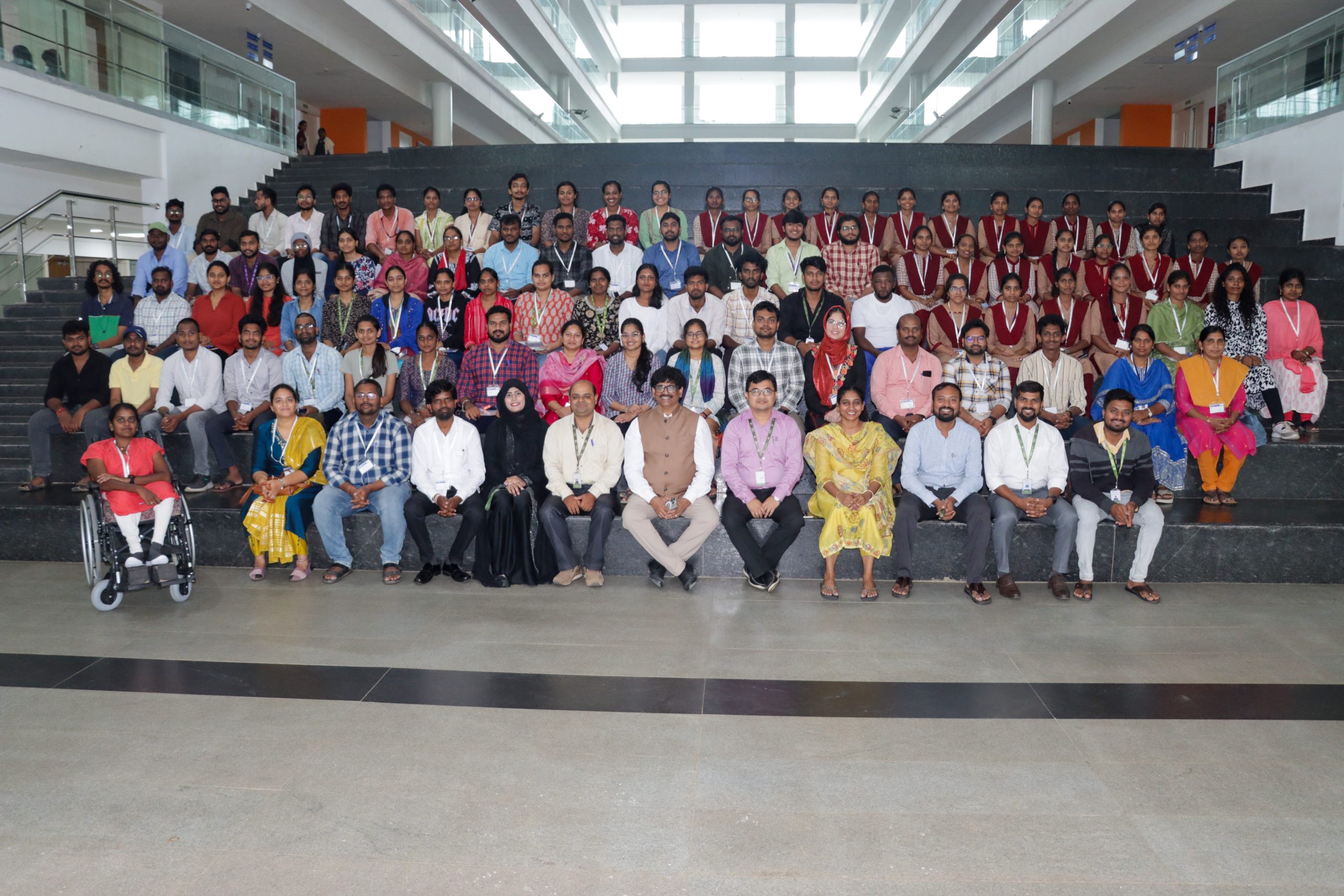 A two-day hands-on training for about 110 to 113 attendees, including undergraduate, postgraduate and PhD Scholars, was conducted by the Office of Dean Research. The Users Meet on NMR Spectroscopy was primarily aimed at:
A two-day hands-on training for about 110 to 113 attendees, including undergraduate, postgraduate and PhD Scholars, was conducted by the Office of Dean Research. The Users Meet on NMR Spectroscopy was primarily aimed at:
- Enhancing participants’ conceptual and practical understanding of advanced spectroscopic techniques used in the structural elucidation of chemical compounds.
- Demonstrate the application of 1D and 2D NMR techniques in organic, inorganic, and biological systems.
- Promote hands-on exposure to modern NMR instruments, emphasising sample preparation, data acquisition, and spectral interpretation.
- Facilitate interactions between participants and domain experts to encourage academic collaboration and knowledge exchange.
- Strengthen the institutional vision of supporting multidisciplinary research through access to cutting-edge scientific infrastructure.
The event saw the presence of dignitaries like Prof. Ch. Sathish Kumar, Pro Vice-Chancellor; Prof. Ranjit Thapa, Dean of Research; Dr Paradha Saradhi Maram, Associate Professor and Head; and Dr Sabyasachi Mukhopadhyay, Associate Professor, among others.
The workshop held multiple sessions, including theoretical sessions, practical sessions, and interactive sessions. In the theoretical session, Dr Ramaraju Korivi explained the principles of NMR Spectroscopy. he also covered an instrumentation overview and data interpretation techniques. The session was further enriched by Mr Sakthi Ganapathi R, a PhD scholar. The interactive session saw Mr Arun Kumar Bandarapu enhancing the understanding of advanced characterisation techniques beyond NMR, including SEM, XPS, TEM, EPR, and more. The hands-on session was meticulously coordinated by Ms. Afreen Shaik, Dr. Ramaraju Korivi, and Mr. Sakthi Ganapathi R, providing participants with immersive, real-time exposure to the operational aspects of NMR spectroscopy
Beyond the three sessions, the workshop also included a session on sample analysis and an I-STEM. Together, the two-day workshop proved to be an enriching and skill-building platform for the students.
- Published in Departmental News, News, Research News, Uncategorized
Ensuring Food Safety through Artificial Intelligence
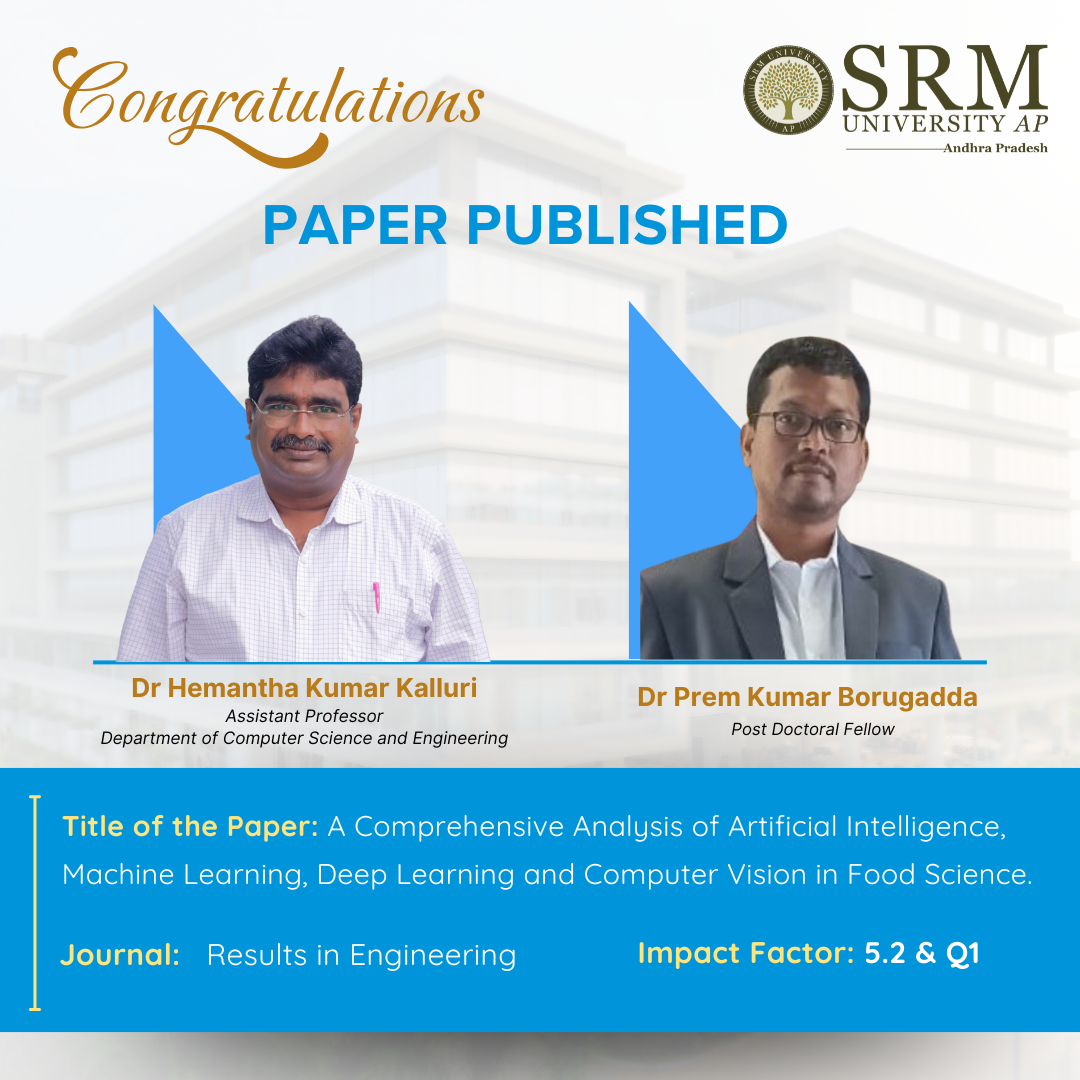 Assistant Professor Dr Hemantha Kumar Kalluri from the Department of Computer Science and Engineering and post-doctoral fellow, Dr Premkumar Borugadda have published a research paper titled, A Comprehensive Analysis of Artificial Intelligence, Machine Learning, Deep Learning and Computer Vision in Food Science. This significant research explores how Artificial Intelligence (AI), Machine Learning (ML), Deep Learning (DL), and Computer Vision (CV) are making food processing smarter and more reliable.
Assistant Professor Dr Hemantha Kumar Kalluri from the Department of Computer Science and Engineering and post-doctoral fellow, Dr Premkumar Borugadda have published a research paper titled, A Comprehensive Analysis of Artificial Intelligence, Machine Learning, Deep Learning and Computer Vision in Food Science. This significant research explores how Artificial Intelligence (AI), Machine Learning (ML), Deep Learning (DL), and Computer Vision (CV) are making food processing smarter and more reliable.
Here’s a brief on their findings and the social and practical implementations of their work.
A Brief Abstract
Providing safe and quality food is crucial for every household and is of extreme significance in the growth of any society. It is a complex procedure that deals with all issues focusing on the development of food processing from seed to harvest, storage, preparation, and consumption. This current paper seeks to demystify the importance of Artificial Intelligence (AI), Machine Learning (ML), Deep Learning (DL), and Computer Vision (CV) in ensuring food safety and quality. By stressing the importance of these technologies, the audience will feel reassured and confident in their potential. These are very handy for such problems, giving assurance over food safety. CV is incredibly noble in today’s generation because it improves food processing quality and positively impacts firms and researchers. Thus, at the present production stage, rich in image processing and computer visioning is incorporated into all facets of food production. In this field, DL and ML are implemented to identify the type of food in addition to quality. Concerning data and result-oriented perceptions, one has found similarities regarding various approaches. As a result, the findings of this study will be helpful for scholars looking for a proper approach to identify the quality of food offered. It helps to indicate which food products have been discussed by other scholars and lets the reader know papers by other scholars inclined to research further. Also, deep learning is accurately integrated with identifying the quality and safety of foods in the market. This paper describes the current practices and concerns of ML, DL, and probable trends for its future development.
Explanation of the Research in Layperson’s Terms
The research explores how Artificial Intelligence (AI), Machine Learning (ML), Deep Learning (DL), and Computer Vision (CV) are making food processing smarter and more reliable.
AI and ML in Food Processing
- AI-powered systems can predict food spoilage, detect harmful contaminants, and ensure food is stored at the right temperature.
- ML models learn from past data to improve food quality, making processing more efficient and reducing waste.
Computer Vision (CV) for Food Inspection
- Cameras powered by AI can analyse food products and detect defects, ensuring only high-quality food reaches consumers.
- CV helps in sorting fruits and vegetables based on size, colour, and ripeness, reducing human error and speeding up production.
- It is also used to check food packaging for defects and prevent contamination.
Deep Learning for Better Food Safety
- Deep learning, a more advanced type of AI, helps identify patterns in food quality data.
- It is used to detect food adulteration (unwanted substances added to food), ensuring that the food we consume is pure and safe.
- DL models can also classify different types of food and analyse their nutritional content.
Future of Smart Food Processing
- As AI and ML continue to evolve, food production will become more automated, reducing human labour while increasing efficiency.
- These technologies will help minimise food waste, improve supply chains, and provide personalised nutrition recommendations.
- By integrating AI with real-time monitoring, food safety can be ensured on a global scale.
Practical Implementation and Social Implications
The research on Artificial Intelligence (AI), Machine Learning (ML), Deep Learning (DL), and Computer Vision (CV) in Food Science has significant real-world applications and social implications:
Practical Implementation
Our research has directed the researchers to develop applications in various stages of the food industry, from agriculture to food processing, quality control, and distribution. Here are some key practical implementations:
- Smart Food Inspection and Quality Control
1.1 Computer Vision (CV) & Deep Learning (DL) for Defect Detection
- AI-powered cameras can detect defects in fruits, vegetables, and packaged food (e.g., detecting bruises in apples and sorting out contaminated grains).
- AI enhances automated food grading and sorting, reducing human error.
1.2 AI for Food Adulteration Detection
- AI models analyse food samples for contaminants, chemical adulterants, and spoilage (e.g., identifying milk adulteration using spectral data).
- Deep learning algorithms predict shelf life based on packaging conditions.
2. AI in Food Safety and Hygiene Monitoring
2.1 AI-based Sensors for Real-time Food Safety Checks
- AI-driven sensors monitor temperature, humidity, and hygiene conditions in food storage units and supermarkets.
- ML-based forecasting predicts food spoilage before it happens, reducing foodborne diseases.
This research bridges the gap between technology and food security, ensuring that AI and ML can revolutionise the way food is produced, processed, and consumed. These technologies enhance quality control, reduce food waste, ensure hygiene, and support sustainable agriculture, leading to a healthier, safer, and more efficient global food system.
Future Research Plans.
AI-Powered Automated Food Sorting & Grading
- Use Computer Vision & Deep Learning to automate sorting of grains, fruits, and vegetables based on size, ripeness, and defects.
- Implement Deep Learning models for real-time sorting in food processing units.
- Published in CSE NEWS, Departmental News, News, Research News
Dr Sayantan Decodes Gender Paradox in Bāul Philosophy
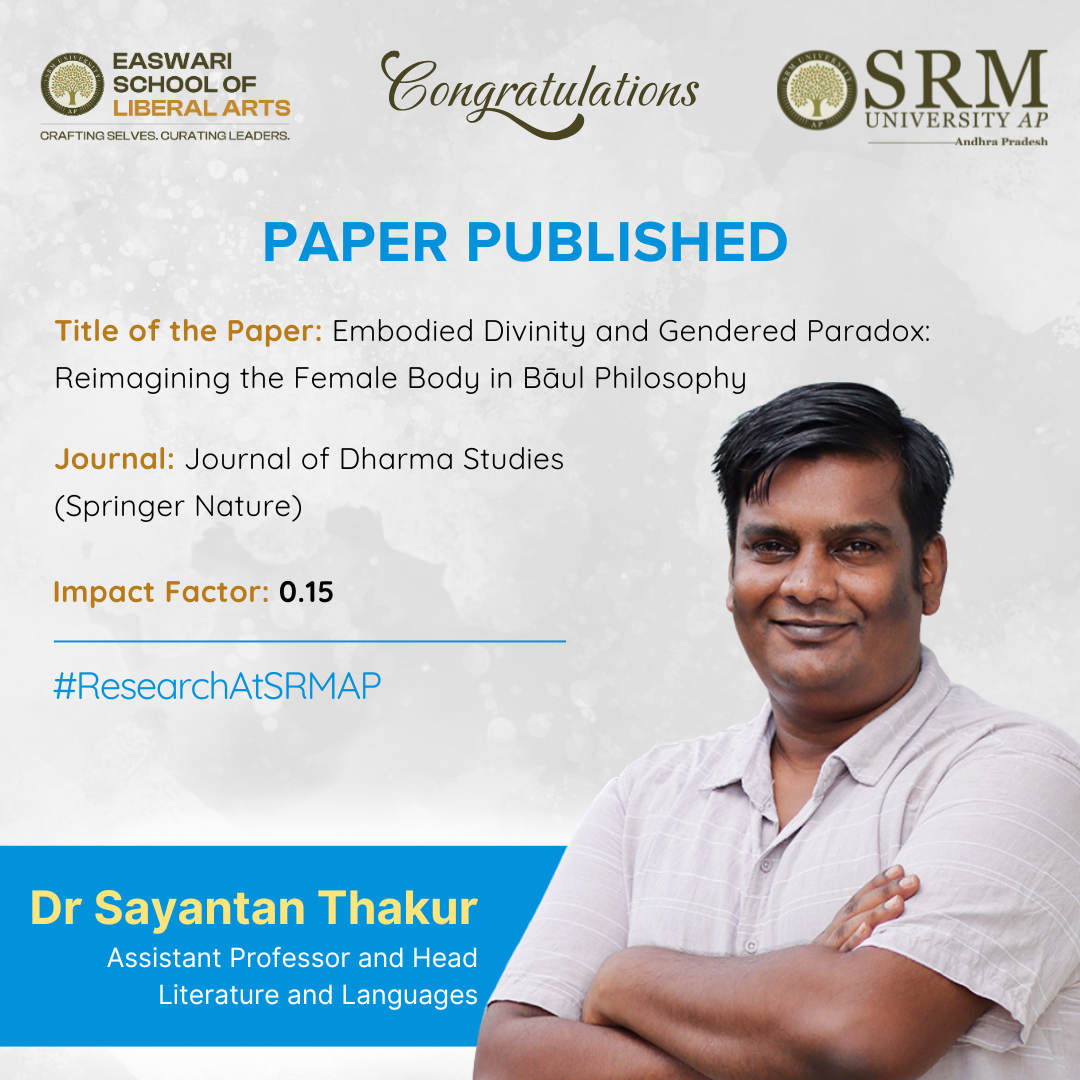 Dr Syantan Thakur, Assistant Professor at the Department of Literature and Languages in the Easwari School of Liberal Arts, analyses the Bāull Philosophy through its stories and songs, which project women as a vessel for spiritual realisation and at the same time subject her individuality so as to idealise patriarchal norms. Read the interesting excerpt about his paper to learn more about the topic.
Dr Syantan Thakur, Assistant Professor at the Department of Literature and Languages in the Easwari School of Liberal Arts, analyses the Bāull Philosophy through its stories and songs, which project women as a vessel for spiritual realisation and at the same time subject her individuality so as to idealise patriarchal norms. Read the interesting excerpt about his paper to learn more about the topic.
A Brief Abstract of the Research
This research explores how the Bāul tradition of Bengal represents the female body within its mystical and countercultural spiritual philosophy. Central to Bāul belief is deho-tattva—the philosophy that the human body, especially the female body, is the vessel through which spiritual realization is possible. The paper critically examines how women’s bodies are portrayed as sites of divine power (śakti) but are simultaneously idealized in ways that risk reinforcing patriarchal structures. By drawing on feminist theorists like Simone de Beauvoir, Judith Butler, Luce Irigaray, and Rita Gross, the study interrogates whether the Bāul tradition’s symbolic reverence of women genuinely affirms women’s agency or instead reduces them to metaphors for male spiritual advancement. Using Bengali Bāul songs, ethnographic insights, and comparative references to other South Asian mystical traditions, this research argues that the Bāul approach embodies both liberatory and constraining elements for women. The paper calls for an intersectional feminist lens to reconcile these contradictions and to imagine a spiritual practice that fully recognizes the lived experiences and autonomous subjectivity of women within the Bāul cosmos.
Explanation of the Research in Layperson’s Terms
This study looks at a group of mystical singers and spiritual practitioners in Bengal called the Bāuls. They believe that the human body, especially a woman’s body, is sacred and full of divine power. Unlike some other religious traditions that say we should reject the body to find God, the Bāuls say we should honor the body because it connects us to the divine. However, there’s a twist: while the Bāuls praise women’s bodies as powerful and holy, they often do this in ways that turn real women into symbols instead of seeing them as people with their own voices and choices. My research asks: does calling a woman “divine” really help her in everyday life, or does it just make her part of someone else’s story? By studying Bāul songs and talking about feminist ideas, my work tries to show both sides of this spiritual practice—how it can free women from some social limits but also how it might quietly keep old inequalities alive. In the end, it’s about finding a fair balance between spiritual ideas and real-life respect for women
Practical Implementation and Social Implications
This research has important implications for how we think about gender, religion, and cultural traditions today. First, it encourages scholars, artists, and spiritual communities to look critically at how women are represented—not just as sacred symbols but as real people with voices and choices. For Bāul practitioners and followers, the study invites reflection on how to preserve the liberating parts of their tradition while addressing parts that may still reflect patriarchal ideas. Socially, the paper highlights the need for conversations about how spirituality and feminism can work together, especially in India where women often face both religious and cultural restrictions. By showing how the Bāuls both challenge and sometimes uphold old gender roles, this research can help communities, policymakers, and educators find better ways to support women’s rights within cultural practices. Practically, it suggests that empowering female Bāuls—called Bāulinīs—to share their own stories, perform publicly, and teach in their own voices can shift the tradition toward greater gender equality. Overall, this study shows that spiritual traditions can be part of modern conversations about gender justice if we approach them with openness, respect, and critical thinking.
Future Research Plans
- Regional Literature in Translation
- Tantric Tradition and Eastern Indian Literature
- Folk Music of Bengal
- Indian Philosophy, Aesthetics & Literature
- Published in Departmental News, English Current Happenings, English news, News, Research News


